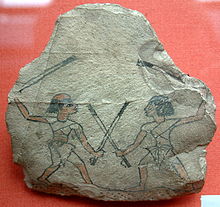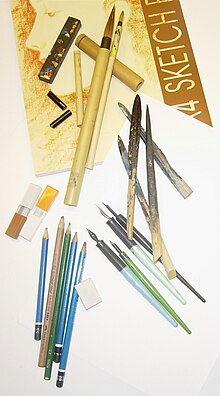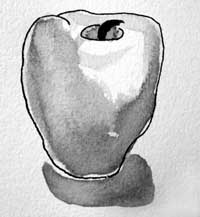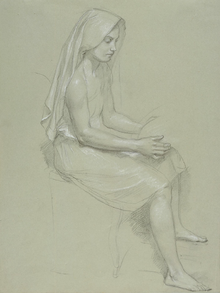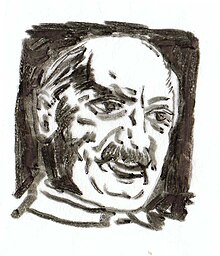Drawing (art)
A drawing is an image that represents a motif ( subject ) in a simplified manner using lines and strokes. This distinguishes drawings from painting , which depicts a motif through the use of two-dimensional use of colors and tonal values .
Since the 19th century, the term graphic has established itself as a technical term for all non-painting two-dimensional representations , which also makes it clear that “drawing” is related to “ sign ” in terms of the history of the concept . In addition to the drawing, the graphics also include prints , mosaics and sgraffito .
According to the classical view a drawing in the strict sense emphasizes the outline lines of a subject. These lines can be supplemented with the help of further lines ( hatching ) in order to create a spatial impression. The display is either monochrome or uses predetermined colors that are not mixed together before application. Today, however, numerous mixed techniques are used in artistic drawing, through which the academic boundary to painting cannot always be clearly drawn in practice. In addition to lines and strokes, brush drawings already use wash as a means of representation.
As a rule, the artistic drawing is a hand drawing (also free-hand drawing). Drawings can, however, also be designed with aids ( rulers , templates ); this is often the case with technical drawings .
history
Beginnings
The beginnings of drawing coincide with the beginning of human cultural history. The oldest evidence is rock carvings from around 36,000 BC. The main themes are hunting, war and probably magical symbols . It is assumed that these works are of religious and magical origin, for example to influence the outcome of the hunt or armed conflicts. In addition to drawings carved into the rock, the primeval painters used charcoal and painting and drawing materials such as ocher made from earth and plants . Significant finds come from Altamira in Spain and Lascaux in France .
All later advanced civilizations produced works based on the use of lines. Often these works are either closely related to the development of writing or are formalized signs and symbols without individual expression. The drawing underwent a significant further development from around 3000 BC. In Egypt and later in the Roman Empire with the fresco , a decorative wall painting that often shows traces of preliminary drawings. Sketches for such frescoes have been handed down on pottery shards ( ostraka ). From 1000 BC In BC clay vases became an important vehicle for drawings, especially in Attic culture. First, lines were scratched into the untreated clay. Elaborately designed drawings from a later period can be found on vessels primed in white. It is known from written records that from 500 BC onwards In the entire Mediterranean area drawings were made on primed wood and with silver pen on parchment. However, because the material is easily transient, no examples have survived.
middle Ages

In the Middle Ages , drawing was not only important as a means of design for painting, sculpture and architecture , but also gained a new high point, especially in book illumination . However, it remains integrated in its function, so it is not an independent work of art. The most important expression of the art of drawing are miniatures and marginal drawings on the margins of valuable manuscripts. The masterful mastery is particularly evident in the manuscripts of Irish Scottish and Italian monasteries and abbeys. One of the most important documents is the Irish Book of Kells from the 9th century. With the possibility of papermaking , which from the 14th century increasingly took the place of expensive parchment , studies and exercise drawings became possible. In European painting schools, master drawings and sketchbooks are widespread, which the students use as templates for their reproductive work according to the painting rules of the respective master. Although the name of the medieval book illustrations painting is common, it is usually to colored drawings, as they are created signatories ( Adumbrator ) and painters ( illuminator ) one after the illustration created.
Modern times
In the 15th century the drawing began to gain independence. The most important aesthetic innovation of this time is the development of the central perspective , which goes hand in hand with a new attempt at realistic representation. Antiquity and its works of art are elevated to an aesthetic ideal ( Renaissance ). The drawing is of particular importance as a means of study and as a design medium. It is also becoming a popular collector's item, which explains the rich tradition since that time.
Drawing reached a new high point in the Italian Renaissance, and particularly in Mannerism . Many drawings are contained in sketchbooks, indicating that drawing was the preferred medium for pictorial study. The most important drawing tools are silver pencil, charcoal, red chalk and white chalk. Pen, brush and ink are also used. In terms of style, there are clear differences between northern and southern Europe. While painting is the main artistic medium in southern Europe, in northern Europe it is especially prints and engravings. This influence is unmistakable in the drawings from Germany and Holland. In the Baroque and Rococo periods , painting dominated the drawing style in the north as well. The most important draftsman of this time is Rembrandt , who left over 2000 drawings, mostly studies and drafts.
In the 18th century, a new development impulse for drawing came from the new development of colored chalks and pastel colors. Above all, Antoine Watteau experimented with these new media and developed a formative language of form. Popular subjects are portrait studies - an expression of the bourgeois emphasis on the individual - and landscape drawings. The drawing gains more and more different design elements. An expression of this is, for example, the close connection between drawing and watercolor .
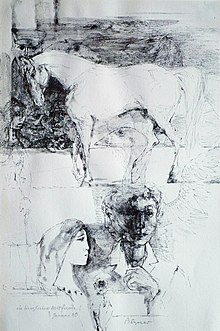
Modern
Modern drawing since the end of the 19th century has been characterized by a great deal of freedom in the choice of drawing means. The border between painting and drawing is all the more blurred when the color design, for example with the help of pastel colors and chalk, or the plastic design by smudging and rubbing the uniqueness of the line into the background. In some directions, such as pointillism and impressionism , the means of drawing seem to be disappearing entirely. In Expressionism, the line gives way to the expressive, dramatic stroke. On the other hand, Pablo Picasso , for example, has paintings that are made up of nothing more than the line. Whether a picture is a drawing or a painting can no longer be clearly answered using the classic criteria. But that is precisely one goal of the various art movements up to the first half of the 20th century: the academic formal rules should no longer simply apply.
Although some important artists have repeatedly produced drawings since the end of the 19th century, one speaks of a crisis of drawing in modern times due to the ambiguity of the means of drawing. The aesthetic high culture focuses on the classic modes of painting, sculpture and architecture. As a medium in its own right, the drawing gains importance especially in popular culture, for example in the form of caricatures and comics . Notwithstanding this, drawing productivity has remained unbroken since the end of the Second World War. Drawers such as Alberto Giacometti , Horst Janssen , Gunter Böhmer and AR Penck have given new impulses for modern drawing in their own way.
East Asian drawing art

In the East Asian region, especially in China and Japan , an art of drawing has developed since the Tang dynasty (6th century) that can only be partially classified in the European categories of drawing and painting. This so-called ink painting emerged from Chinese calligraphy and is created using brushes and black ink or soot . Brush drawing and washing dominate the drawing techniques, which is why the East Asian ink style is often compared to watercolor .
The Chinese poet and calligrapher Wang Wei is considered to be the founder . Starting with the brushstroke when writing characters, he developed a drawing technique that reduces a landscape to its essential lines and shades. Up to the 11th century ( Song dynasty ) the technology was continuously developed and refined. A rich vocabulary of forms develops with which the motifs are represented. From the 12th century onwards, in addition to the landscape motif, there were other natural motifs and increasingly detailed studies. Calligraphic poems are often included in the design.
The ink drawing is from the beginning in close connection with the Chan - Buddhism and is therefore also a meditation exercise . From the 13th century onwards, Japanese monks who studied Chan Buddhism in China brought ink drawings to Japan , where it became an important part of Zen Buddhism under the name Sumi-e . As in China, most of the draftsmen were not artists, but monks and priests. First of all, the Japanese style remains very similar to the Chinese, especially when it comes to the vocabulary of forms. With Sesshū Tōyō (1420–1506), he was also a Zen priest, his own Japanese style gradually developed, leaving the classic forms of representation behind and increasingly striving for realistic images. With Sesshu, Sumi-e becomes an independent art form, which, however, never completely leaves the Zen background.
Asian ink drawing has exerted a strong fascination on European drawing and painting since Impressionism at the latest . Painters and draftsmen such as Degas , Monet , Picasso and Horst Janssen have been clearly inspired by ink drawings in their works and have created works themselves, especially in the sumi-e style.
theory

The drawing emphasizes the lines and outlines of a depicted object. The line as an artistic medium is itself abstract. Insofar as the drawing objects naturalistic , i. H. "According to nature ", the draftsman reduces nature to what is essential to the eye, perception . The abstraction and reduction of visual information to the bare outline is a significant intellectual achievement. That is why the school of drawing is also generally regarded as the primary school of attentive and precise vision.
Nevertheless, the independent value of a drawing has only gradually been recognized since the 15th century. Although drawing was already regarded as a basis of art in medieval art theory, it was only a means of practice and learning, not an autonomous work of art. In the theoretical evaluation of drawing in relation to painting , it was unclear what is more fundamental: the development of the picture from the line or from the color. Traditional drawings from this period are sketches , drafts , studies and preliminary studies for painting. The fact that drawings have survived at all is due to the fact that these drawings were very popular as gift sheets, especially if they came from famous painters or were preliminary studies of famous works. However, the basic evaluation was stuck to: The theoretical consideration was based on a two-stage model, namely the idea for a picture as it is reflected in a sketched drawing and the implementation of the idea as the actual artistic achievement. Significant draftsmen such as Leonardo da Vinci and Albrecht Dürer saw drawing primarily as an opportunity to systematically work out a subject, with the aim of using these studies for the second stage, for example in a painting. As an intermediate step from the idea to the execution, the water color , which in art theory was for a long time assigned and subordinated to the drawing itself, was seen as a subsequently colored drawing.
The appreciation of drawing in art theory begins with Federico Zuccaro's reflections on the relationship between idea (concetto) and drawing (disegno) (1607). In the dispute between the primacy of line and the primacy of color , he takes the side of the draftsman . Zuccari compares the drawing with the divine act of creation. At the beginning of creation there is an idea as a kind of inner drawing (concetto; concept). This mental act is expressed in the drawing (disegno), which in its originality is one with the idea. It is the necessary external form of the idea. The further artistic development is then only an addition and completion. With his remarks, Zuccari takes a stand on a dispute which initially took place in the academic art of Italy, but which soon spread across Europe. In addition to Italy, a focus of the dispute is France, where the so-called Poussinists advocate the primacy of line and the Rubenists for the primacy of color .

The academic discourse leads to a general recognition of the primacy of the line, with the result that drawing is declared to be a basic technique in drawing theory. However, there is a tendency to shorten the drawing to drawing technique and to ascribe more to it the character of preparatory study and exercise. At the same time, however, the drawing is also increasingly recognized as an independent artistic expression. A broad collector's movement is doing the rest to establish the drawing alongside academic debates on the developing art market. It was above all lovers and connoisseurs who helped the intrinsic value of linear representation to break through in the 18th century. In particular, Pierre-Jean Mariette emphasizes in its publications the special value of the black and white contrast without coloration. Mariette's view that the line allows the matter to be recognized and thus works out the essentials of a pictorial representation, is generally accepted and paves the way for the upgrading of the drawing as an independent art genre in the 20th century.
This process is supported in the 19th century by the romantic discovery of the aesthetic appeal of the fragment. The fragment as the broken off and unfinished is just being discovered in the drawing. It contains the ingenious original idea that is fascinating precisely because it remains unrealized. Instead, the draftsman's handwriting becomes visible in the drawing: you can see him at work, so to speak. In Georg Wilhelm Friedrich Hegel , therefore, the drawing is regarded as one of the highest arts.
The theoretical distinction between drawing and painting remained until the end of the 19th century. The drawing also retains its subordinate rank in the academic assessment. However, artistic practice is increasingly beginning to break away from the normative demands of academic aesthetics . Artists like Paul Cézanne begin to question the principle of the line for drawing and develop drawings from impressions of color. The old discussion between “draftsmen” and “painters”, who asked about the primacy of line or color in painting, now concerns the drawing itself. It is no longer limited to linear representation and reduced use of color. The various art movements at the beginning of the 20th century take up this approach, so that the theoretical boundary between painting and drawing is increasingly blurred. Current aesthetic theory laments the lack of a theory of drawing.
Drawing material
Drawing reasons
Basically, a drawing carrier can be any surface to which drawing materials adhere or into which lines can be scratched. In cave art it was a rock wall, later wood, clay and stone slabs, and until the Middle Ages leather and parchment. In most cases today, paper is used as a carrier for drawings. This also includes colored or color-primed paper and cardboard . Artist papers are often heavy papers with a clear texture , they are often special watercolor or pastel papers or handmade paper.
Drawing means
When it comes to drawing materials, a distinction is made between dry and liquid drawing materials. The dry drawing materials include a. Graphite and metal mines, coal , various chalks and wax . Among the liquid character agents include gall ink , sepia (a dye that has been made in the 18th century can also be used for artistic purposes) and from soot produced Bister . To name would be even ink , acrylic and oil paints and besides the various watercolors mainly still opaque white that the levels used for drawings. Various drawing implements are used to apply primarily wet drawing materials.
Drawing devices
The most widely used drawing implements for applying dry drawing materials are graphite, lead and red chalk pencils of various degrees of hardness. In the 15th and 16th century mainly used silver pins later also mines of lead . Today pencils have a lead made of graphite, which is surrounded by a wooden jacket. Graphite pencils do not have a wooden casing, but are coated with lacquer or plastic for better handling . Technical holders such as mechanical pencils and mechanical pencils are also used to hold the mines.
Also Coal and Conté pencils thus are often used in wood sheathing or with special brackets, the same goes for pastels . Oil and wax crayons , on the other hand, are often used with just a paper cover. However, there are also special holders for this.
Liquid drawing materials ( inks or inks) are usually applied with pens or brushes . As springs next to come bamboo - and reed pens and quills especially steel springs are used. Isographs are mainly used for technical drawings . In principle, fiber pens can also be used, but the liquid drawing materials used in them are often not very lightfast . The same problem occurs with ballpoint pens , fountain pens and calligraphy pens , as the inks used are usually not lightfast and fade easily.
Brushes are used both for drawing lines and for washes , that is, for painting techniques. Mostly they are fine hair brushes or higher quality synthetic brushes or a mixture of both. So-called Chinese brushes are particularly popular for brush drawing .
techniques
The line
The basic technique of drawing is drawing a line. In pure contour drawing, the line marks the boundaries of the outlines of an object and characteristic contrasts that result from the shadow . Without any shading, the main features of an object can be captured, for example the outlines of a fruit that is differentiated from its background, and wrinkles, which are nothing more than contrasting shadows. Even if the representation is not representational, the line is the most prominent feature, even if the boundaries cannot always be clearly drawn in modern drawings.
History of the line
The line as the specific characteristic of drawing has seen historical developments: Although the line is to be seen as the individual trademark of every draftsman, there was a generally recognized line type in the Renaissance , the "beautiful" line, which was round, swinging or curved. In addition, straight and rigid line types existed in the field of architectural drawing . The full richness of lines came about with impressionism , because the relationship to the descriptive object loosened. A “liberation of the line” towards non-representational drawing did not take place until the 19th century, for example in the work of Honoré Daumier . The previously dominant beautiful, curvy line has now been supplemented by angular, bulky and ruinous line types that were previously not considered worthy of a picture. New ways of expressing the line were also found in the work of Paul Klee and the expressive drawing by Pablo Picasso .
hatching
The hatching continues the graphic idea of the line in the surface. It is used to represent spatial effects and different tonal values in the drawing . To do this, thin lines are drawn at even intervals at an angle to the main line. In pure drawing, it is frowned upon to draw the lines so tightly that they smear - for example with a pencil held at an angle - because this crosses the border to painting as a two-dimensional work. This is called "dumb". In the meantime, however, this two-dimensional work with graphite and carbon pencils is also widespread.
Further gradations in the tonal values can be created by a second hatching, which is set slightly offset over the first hatching and crosses its lines. This is why one speaks of cross hatching . Using cross hatching, many different shades and tonal values can be created with the same line thickness. Cross hatching is of particular importance when working in color, because different colored hatching can create new colors .
Wash
The wash is used in liquid drawing materials as a technique for shading and tinting. The classic area of application is washing ink drawings. For this purpose, the finished line drawing is tinted with heavily diluted, water-soluble ink. As with watercolor , from which this technique was adopted, you work from light to dark tones. The proximity of watercolor painting and drawing is also evident in the fact that drawings are tinted in color with the help of watercolor paints - either monochrome or with several colors. In practice, other colors are sometimes used, but watercolors and water-soluble inks are particularly suitable because they are transparent or at least only partially opaque and thus avoid the impression of merely being tinted or colored afterwards.
Combined techniques
Many artists go beyond the boundaries of certain drawing techniques by combining different drawing and painting techniques. Classic examples are combined graphite and ink drawings, pencil drawings washed with ink, or ink and pencil drawings with watercolor techniques. The heights, i.e. the setting of highlights through the use of opaque white, is also one of the classic methods.
The more the boundaries between painting and drawing were blurred, the more flat painting methods were used. This includes, for example, shading with the help of " shading ". Shading means painting over a large area with a graphite or charcoal pencil instead of hatching. Subsequent smudging with your finger or a special wiper ( estompes ) or polishing with a white pen or polishing pen are also part of this. Conversely, traditional drawing methods are originally used in painting, not just as a preliminary sketch, but as an execution. Brush drawings are often used in watercolor painting .
Further examples of combined techniques are collage , sgraffito and various wet brush techniques.
Outstanding illustrators in art history

- Hans Baldung
- Max Beckmann
- Joseph Beuys
- Lovis Corinth
- Honoré Daumier
- Gustave Doré
- Albrecht Dürer
- MC Escher
- Francisco de Goya
- George grosz
- Jean-Auguste-Dominique Ingres
- Horst Janssen
- Käthe Kollwitz
- Alfred Kubin
- Michelangelo
- Pablo Picasso
- Rembrandt
- Raffaello Santi
- Egon Schiele
- Giovanni Battista Tiepolo
- Tomi Ungerer
- Leonardo da Vinci
See also
literature
- An Introduction to Linear Drawing
- FW Bernstein : Bernstein's book of drawing . 1989. A teaching, pleasure, non-fiction and specialist book beyond compare. Edited by FW Bernstein with the editorial assistance of Pedro Zimmermann. Zurich (Haffmans)
- Claus Bernet : Drawings. Norderstedt 2014, ISBN 978-3-7347-0830-5 .
- Disegno. The draftsman in the picture of the early modern period . Staatliche Museen zu Berlin, 2007. ISBN 978-3-422-06774-5
- Betty Edwards : Learn to draw the new guaranteed , Rowohlt 2000, ISBN 3-498-01669-5 .
- Heribert Hutter : The hand drawing. Development, technology, material . Schroll-Verlag, Vienna and Munich 1966.
- Ferenc Jádi : From the drawing . 1998, ISBN 3-932865-04-9 .
- Walter Koschatzky : The Art of Drawing . dtv 1981, ISBN 3-423-02867-X .
- Terisio Pignatti : The History of Drawing. From the origins to today . Belser-Verlag, Stuttgart 2005, ISBN 3-7630-2451-4 .
- Franco Russoli: Master Drawings of the 20th Century , Schuler Verlag, Munich 1975, ISBN 3-7796-5044-4 .
- Maurice and Arlette Sèrullaz: French master drawings of the 19th century , Schuler Verlag, Munich 1975, ISBN 3-7796-5060-6 .
- German drawings from the Middle Ages to the Baroque , inventory catalog, edited by the Stuttgart State Gallery's graphic collection, Hatje Cantz Verlag, Ostfildern 2007, ISBN 978-3-7757-1910-0 .
- Dieter Brembs: The Art Academy. Line fascination. Experience drawing in a new way. English publisher , Wiesbaden 2006, ISBN 978-3-8241-1300-2 .

